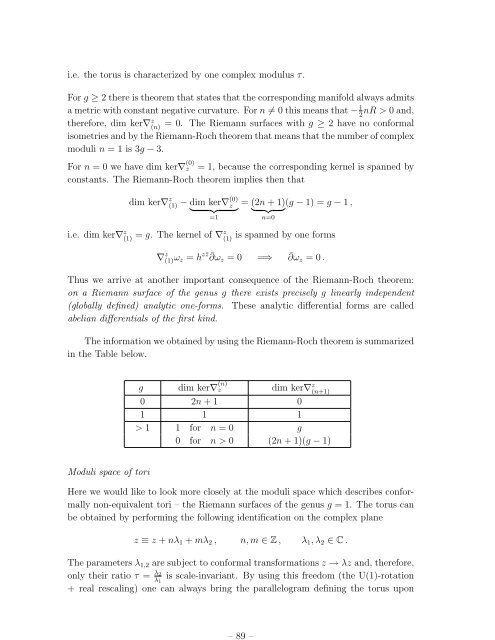Lectures on String Theory
Lectures on String Theory
Lectures on String Theory
You also want an ePaper? Increase the reach of your titles
YUMPU automatically turns print PDFs into web optimized ePapers that Google loves.
– 89 –<br />
i.e. the torus is characterized by <strong>on</strong>e complex modulus τ.<br />
For g ≥ 2 there is theorem that states that the corresp<strong>on</strong>ding manifold always admits<br />
a metric with c<strong>on</strong>stant negative curvature. For n ≠ 0 this means that − 1 nR > 0 and,<br />
2<br />
therefore, dim ker∇ z (n)<br />
= 0. The Riemann surfaces with g ≥ 2 have no c<strong>on</strong>formal<br />
isometries and by the Riemann-Roch theorem that means that the number of complex<br />
moduli n = 1 is 3g − 3.<br />
For n = 0 we have dim ker∇ (0)<br />
z = 1, because the corresp<strong>on</strong>ding kernel is spanned by<br />
c<strong>on</strong>stants. The Riemann-Roch theorem implies then that<br />
dim ker∇ z (1) − dim ker∇ (0)<br />
z = (2n + 1) (g − 1) = g − 1 ,<br />
} {{ } } {{ }<br />
=1<br />
n=0<br />
i.e. dim ker∇ z (1) = g. The kernel of ∇z (1)<br />
is spanned by <strong>on</strong>e forms<br />
∇ z (1)ω z = h z¯z ¯∂ωz = 0 =⇒ ¯∂ω z = 0 .<br />
Thus we arrive at another important c<strong>on</strong>sequence of the Riemann-Roch theorem:<br />
<strong>on</strong> a Riemann surface of the genus g there exists precisely g linearly independent<br />
(globally defined) analytic <strong>on</strong>e-forms. These analytic differential forms are called<br />
abelian differentials of the first kind.<br />
The informati<strong>on</strong> we obtained by using the Riemann-Roch theorem is summarized<br />
in the Table below.<br />
g dim ker∇ z<br />
(n) dim ker∇ z (n+1)<br />
0 2n + 1 0<br />
1 1 1<br />
> 1 1 for n = 0 g<br />
0 for n > 0 (2n + 1)(g − 1)<br />
Moduli space of tori<br />
Here we would like to look more closely at the moduli space which describes c<strong>on</strong>formally<br />
n<strong>on</strong>-equivalent tori – the Riemann surfaces of the genus g = 1. The torus can<br />
be obtained by performing the following identificati<strong>on</strong> <strong>on</strong> the complex plane<br />
z ≡ z + nλ 1 + mλ 2 , n, m ∈ Z , λ 1 , λ 2 ∈ C .<br />
The parameters λ 1,2 are subject to c<strong>on</strong>formal transformati<strong>on</strong>s z → λz and, therefore,<br />
<strong>on</strong>ly their ratio τ = λ 2<br />
λ 1<br />
is scale-invariant. By using this freedom (the U(1)-rotati<strong>on</strong><br />
+ real rescaling) <strong>on</strong>e can always bring the parallelogram defining the torus up<strong>on</strong>

















